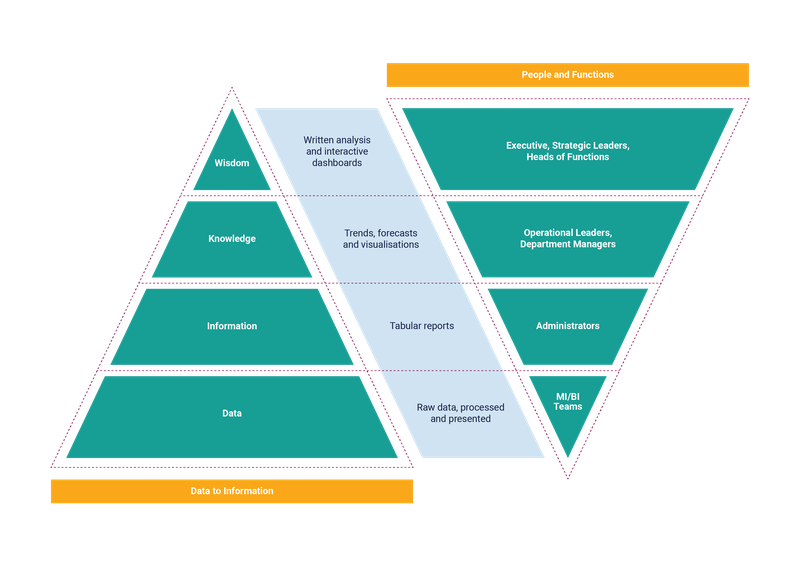Culture
Understanding your current data maturity may reinforce what you feel you already know – or it may provide visibility of a wider range of relevant processes and considerations.
Before you begin to think about what to prioritise, we would strongly advise you take time to reflect on the nature of your organisation and how challenging it may be to progress improvement activities.
Culture is a combination of active decisions relating to values and expectations, and behaviours that may have evolved over a significant period. While senior leaders can influence the former, it is much more complex to address the latter, particularly in the highly devolved environments common in the HE and FE sectors.
In real terms, before embarking on any attempts to develop functions or capabilities, this means focusing on how to engage teams with data and data-related responsibilities. It is not unusual for these teams to be extremely knowledgeable but protective about the work they undertake, often a by-product of the accountability felt by individuals. It also means awareness of how change is managed and undertaken in the organisation, and how effective it is.
Where responsibilities are loosely defined, and where there is overlap between roles and functions, it is challenging to be confident that current practice is fully understood. Developing consensus on what to do next is a further challenge. The time it will take to manage these effectively should not be underestimated.
Explore this section:
What is data?
A commonly heard refrain is "but I just want the data". Data is raw information, held in tables, containing keys and codes that may mean little to most business users.
Processing and transforming this into information for onward use is a critical, and skilled, role, which should be done consistently and efficiently.
In mature environments, more people can access data for onward transformation themselves, but this requires successful governance and mature data practices to work effectively.

Institutional variations
The HE and FE sectors comprise different types of organisations – each type does not necessarily have the same challenges, but there are common themes based on governance, age and size. While all have statutory obligations in terms of data, assurance and learner engagement regardless of student number and type, the decision-making process may vary based on the type of institution (eg executive or federated) and culture. These can have a significant impact on any attempts to develop strategy, data or otherwise, and promote and implement related activities.
Examples of the variety of the sector
| A Russell group university in England | 30,000 students | 10,000 staff |
|
| A general further education college in England | 9,000 students | 600 staff |
|
| An independent training provider in England | 2,500 learners | 150 staff |
|
Challenges
In some cases, misconceptions or blockers can limit the likelihood of progress being made. Some reflect a lack of knowledge or understanding of data, systems and processes and this can take time to address - individuals with this knowledge typically accumulate it over extended periods of time. Others reflect a lack of engagement from senior leaders – where this leads to a lack of support or investment, it is likely to require significant short-term resource to address.
It may be helpful to assess the issues you face and how fundamental they are to making progress.
Blockers
Undocumented IT landscape
Visibility of system dependencies and integrations without which standardisation and the development of meta/reference/master data is hindered.
Non-standard processes and systems
Data is not captured in corporate systems, fields and rules are not used consistently and there are unregulated spreadsheet solutions for core business processes.
Legacy reporting tools and software
Visibility of legacy and siloed reporting tools before new solutions are procured – and clarity on how these tools should be used and by whom.
Current pay bands vs. market rate for specialists
For example, business analysts, BI analysts, ETL developers, data/data warehouse/enterprise architects. These roles attract a premium in the market but may be hard to sit within a leadership focused pay and reward framework.
Misconceptions
We don't need a data strategy
Is there strategy overload? Clarify the purpose of a data strategy and the relationship with IT and digital strategies.
People just need the data
Most people need transformed, structured data, presented as information to enable decision making. Less structured data is typically only used by specialist analysts.
Data governance is just information security
The use and management of data for decision making is not the same as how data is stored and kept secure.
Data governance is just data quality
Data governance is about responsibility and accountability. It should lead to improved data quality.
Next section: road map for improvement
Understanding current maturity will help you communicate the challenges, and opportunities, you face in data management and reporting provision.
The data maturity framework is copyright Jisc and made available under CC BY-NC-ND. Find out more about using content from the data maturity framework.